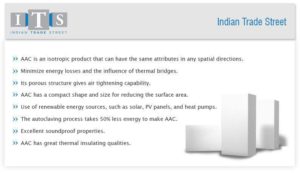Autoclaved Aerated Concrete (AAC) Blocks are the basic needs of any construction project. AAC blocks are an ultra-lightweight, high-insulating, and load-bearing concrete product that contains 80% air in its small voids. AAC has structural and environmental characteristics. AAC Blocks are almost one third to one sixth lighter than conventional red bricks. As it contains excellent properties, it is used in commercial and industrial buildings, residential houses, hospitals, hotels, schools, and many other construction projects.
Table of Contents
Elements
Autoclaved Aerated Concrete (AAC) is used for factory-reinforced roof panels, wall panels, floor panels, lintels, beams, and many more different sizes and shapes. AAC element uses in a variety of applications like commercial, industrial and residential constructions. A reinforced roof and floor panels are used for the horizontal diaphragm system to support the required gravity loads. AAC wall panels are used as a cladding system and load bearing for interior and exterior wall systems. AAC materials vary with manufacturers and locations which include Class F Fly Ash, Fine Silica sand, calcined lime, gypsum, hydraulic cement, and expensive agents.
Production
For manufacturing Autoclaved Aerated Concrete (AAC); the operator grounds sand in ball mill till the finest quality has occurred. After this process raw materials transferred into the mixtures which are divided by weight. The measured water amount and expansive agent to be added to the mixture. Meanwhile, steel moulds are assembled for accepting prepared AAC mixture.
After mixing all materials slurry mixture is ready to pour into the moulds. The expansive agent plays the role of creating the finest scattered and small voids in the AAC mixture. These voids increase in volume by 50% in three hours.
After a few hours of casting, the hydration of the cementitious compound delivers sufficient strength for supporting AAC weight and shape. After cutting, the aerated concrete material is moved to a big autoclave for completing the curing process. For receiving desired structural properties and dimensional stability autoclaving is required and takes 8 to 12 hours.
Construction
AAC has one-sixth to one-third density of conventional concrete and the same property of compressive strength. It is used for cladding and infill’s and for wall bearing components. It is well energy efficient because it has thermal conductivity one sixth-or less than one-sixth to conventional concrete. AAC is porous so it has low sound transmission and acoustic so it is used in hospitals, universities, and soundproof area.
Thermal mass and Thermal insulation
A building that is constructed from AAC is lead to a reduction of overheating because AAC has a thermal mass ability. It has the ability to consuming heat in the hot periods and release in cooling periods. AAC has inherent heat storage and low thermal conductivity capacity.
Building elements made from AAC are low energy losses when the building envelope due to low heat conductivity.
Air tightness
Air tightness is also a property of AAC for heat loss balance. It is as such airtight so constructions no need to use additives such as foils and any other artificially materials. Resultant the interior air climate is good and with healthy humidity control. AAC has a capacity to retain the moisture out of the indoors to a comfortable and healthy atmosphere.
Benefits of Autoclaved Aerated Concrete (AAC)

Conclusion
At the end of this article, I want to conclude that construction made from AAC are well structured and can be fit for any construction projects and it is less expensive and provides a much comfortable infrastructure. Houses made by Autoclaved Aerated Concrete Block have comfortable indoors, sound insulated, air tightening, heat storage, and fire safety capabilities.
🔥881












